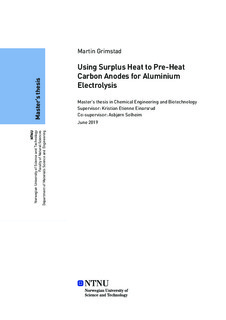| dc.contributor.advisor | Einarsrud, Kristian Etienne | |
| dc.contributor.advisor | Solheim, Asbjørn | |
| dc.contributor.author | Grimstad, Martin | |
| dc.date.accessioned | 2019-10-24T14:01:04Z | |
| dc.date.available | 2019-10-24T14:01:04Z | |
| dc.date.issued | 2019 | |
| dc.identifier.uri | http://hdl.handle.net/11250/2624258 | |
| dc.description.abstract | Karbon anoder brukes opp i Hall-Héroult prosessen og må erstattes regelmessig. Når en ny anode blir plassert i aluminiumsovnen, vil badet umiddelbart fryse på undersiden av anoden og danne et fryst isolerende lag. Denne anodeskiftingen vil redusere strømopptaket og forårsake forstyrrelser til den elektriske og termiske balansen i ovnen i de første dagene etter skiftet.
Eksperimenter for å se på fordelene ved å forvarme karbon anoder ble utført på industriell skala på aluminiumsovner hos Alcoa Mosjøen i Norge. Karbon anodene ble forvarmet ved bruk av overskuddsvarme fra brukte anode butts inne i en isolert anodebeholder før de ble plassert inne i aluminumsovnen. Eksperimentene viste at anoden nådde temperaturer på opptil 150 ºC nært sentrum av anoden og overflatetemperaturer på over 250 ºC ved bruk av butts som varmekilde. Disse temperaturene kan spare opptil 0.018 kWh/kg Al. Strømopptaket til de forvarmede anodene ble målt og sammenlignet med vanlige strømopptak.
Dannelsen av påfryst bad under både forvarmede og vanlige anoder ble observert. Forskjellige forvarmingstider ble brukt og prøver av det påfryste badet ble fjernet fra undersiden av anodene og analysert med en CT-maskin. Forsøk som ble utført viste at lengre forvarmingstid kunne redusere mengden påfryst bad som ble dannet under anodene.
I tillegg ble lufthastigheten og temperaturen inne i ovnen målt ved bruk av pitotrør og termoelementer. | |
| dc.description.abstract | The carbon anodes are consumed in the Hall-Héroult process and must be replaced on a regular basis. When a new anode is placed into the aluminium cell, the bath will immediately freeze on the bottom surface of the anode creating a frozen insulating layer. The anode replacement will reduce the current pick-up rate and cause disturbance to the electrical and thermal balance in the cell in the first few days after replacement.
Experiments to study the benefit of pre-heating carbon anodes were carried out in industrial scale aluminium cells at Alcoa Mosjøen in Norway. The carbon anodes were pre-heated using surplus heat from spent anode butts inside an insulated anode container before being placed into the aluminium cell. The experiments showed that the anode reached temperatures up to 150 ºC near the core and a surface temperature above 250 ºC using butts as heat source. These temperatures could save up to 0.018 kWh/kg Al. The current pick-up rate of the pre-heated anodes were monitored and compared to normal pick-up rates.
The formation of frozen bath underneath both pre-heated and normal anodes were observed. Different pre-heating time was used, and samples of the frozen bath were removed from the bottom surface of the anodes and analysed using a CT-machine. Experiments performed showed that the longer pre-heating time could reduce the formation of frozen bath underneath the anodes.
In addition, air velocity and temperatures were measured inside the cell using a pitot tube and thermocouples. | |
| dc.language | eng | |
| dc.publisher | NTNU | |
| dc.title | Using Surplus Heat to Pre-Heat Carbon Anodes for Aluminium Electrolysis | |
| dc.type | Master thesis | |
